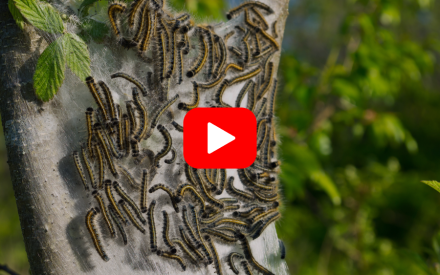Author: Phil Pellitteri, UW Insect Diagnostic Lab
Last Revised: 04/27/2004
D-number: XHT1046
Major branch dieback, plant decline, and plant death on Viburnum species in Wisconsin are commonly associated with the caterpillars of clearwing borer moths. Heavily infested plants appear unhealthy, and often show swelling, cracks and emergence holes at the base of the plant.

Two species of clearwing borer moths, the viburnum clearwing borer, Synanthedon viburni and lesser viburnum borer, Synanthedon fatifera, attack from ground level to about 18 inches above the base of American highbush cranberry and other Viburnum species. Gnarled and scarred stems with sawdust are sure signs of attack. Swellings and callus growth indicate the healing of old injury sites or long standing damage.
Life cycle: Adults of both the viburnum clearwing borer and the lesser viburnum borer are day flying moths that mimic the flight and appearance of wasps. They are bluish black with yellow markings, clear wings and a wingspan of 3∕4 inch. Larvae are pinkish white caterpillars with reddish brown heads. During late June and July, adults emerge from infested plants and deposit eggs on bark near wound sites. Larvae tunnel into the bark and cambium, but do not enter the wood. Over time this tunneling will cause distortions and swellings on the main stems and branches.
Control: Strong vigorous plants are less attractive to borers and more likely to survive attack. Good plant maintenance (e.g., prevention of bark injuries and wounds) will reduce problems. Nursery owners should pay close attention to differences in cultivar susceptibility. Plants that require high maintenance and yearly pesticide treatments should not be produced for sale.
Chemical control is targeted during the adult moth egg-laying period. Larvae under the bark are protected from treatments. Pheromone traps can be used to monitor the first adult activity in spring, and to help time insecticide sprays. Use a spray containing the insecticide permethrin and apply the product from the ground level to about 18 inches up the stem. If traps are not available to aid in the decision-making process, apply insecticides during mid-June and in heavy infestations reapply in mid-July.
For more information on viburnum borer: Contact your county Extension agent.
Thanks to Karen Delahaut and Chris Williamson for reviewing this document.
Download Article





 What’s All the Buzz? Woody Plants for Bees, Butterflies, and Other Bee-t-full Pollinators
What’s All the Buzz? Woody Plants for Bees, Butterflies, and Other Bee-t-full Pollinators ▶︎ Watch: Hydrangeas: Know Them and Grow Them
▶︎ Watch: Hydrangeas: Know Them and Grow Them Promoting Urban Forestry: Planting Bareroot Trees in Home Landscapes
Promoting Urban Forestry: Planting Bareroot Trees in Home Landscapes ▶︎ Watch: Torching Tent Caterpillars
▶︎ Watch: Torching Tent Caterpillars


